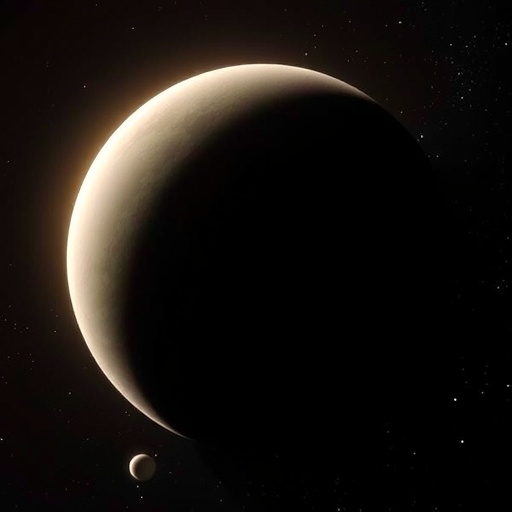University of Warwick astronomers have achieved a groundbreaking discovery that could transform our understanding of planetary systems outside our own. Their research focuses on the phenomena surrounding white dwarfs—dense remnants of stars—and the intriguing possibility that they might be absorbing icy, water-rich fragments from other celestial bodies. This finding not only sheds light on the composition of these distant systems but also highlights the potential for life-related molecules to exist in places previously thought inhospitable.
In our own Solar System, comets and icy planetesimals are known to have played a crucial role in delivering water to Earth. The study of these objects could provide invaluable insights into the conditions necessary for life beyond our planet. However, identifying such icy bodies in distant planetary systems remains an incredibly challenging task due to their small size, faintness, and the complexities involved in chemical analysis.
The researchers from Warwick, alongside collaborators from Europe and the United States, published their findings in the Monthly Notices of the Royal Astronomical Society. Using ultraviolet spectroscopy from the Hubble Space Telescope, they scrutinized the chemical composition of various distant stars—an endeavor that has opened new astrological vistas. Amongst these stars, one, designated WD 1647+375, exhibited a unique volatile-rich atmosphere revealing the presence of elements typically associated with icy worlds.
White dwarfs usually showcase atmospheres packed predominantly with hydrogen and helium. WD 1647+375, however, revealed the presence of additional elements such as carbon, nitrogen, sulphur, and oxygen. This stark departure from the norm prompted the astronomers to delve deeper, leading to a potentially revolutionary realization: this particular white dwarf was not merely absorbing rocky materials, as is commonly observed, but rather a volatile-rich planetary fragment.
Lead author Snehalata Sahu remarked, “It is not unusual for white dwarfs to show signatures of calcium, iron and other metal from the material they are accreting (absorbing). However, the detection of volatile-rich materials is exceedingly rare.” The significance of this observation lies in the implications it holds for our understanding of planetary evolution beyond our Solar System.
By examining the chemical signatures contained in the debris swallowed by WD 1647+375, the researchers uncovered compelling evidence of the planetesimal’s icy composition. Notably, the presence of nitrogen in the stellar debris accounted for approximately 5% of its mass, marking a record high for nitrogen abundance detected in any white dwarf’s accreted material. This additional nitrogen combined with an unexpected abundance of oxygen—84% higher than the typical levels found in rocky debris—points strongly toward the object’s icy origins.
The researchers also gathered data indicating that the star had been feeding on this icy material for a staggering period of at least 13 years, at an astonishing rate of 200,000 kilograms per second. To put this into perspective, that weight is equivalent to that of an adult blue whale! The dimensions of the icy object being consumed suggest it measured at least 3 kilometers across—a size akin to a comet—though it is plausible that, when considering the long-term accretion process, it could have been up to 50 kilometers in diameter and weighed a quintillion kilograms.
The specific findings paint a vivid picture of the icy, water-rich planetesimals present beyond our Solar System. Composed of 64% water, it evokes images of objects like Halley’s Comet or remnants of dwarf planets comparable to the icy celestial bodies in the Kuiper Belt of our own Solar System. Such a discovery emphasizes the potential for complex geological and chemical processes that could facilitate the emergence of life.
In another noteworthy comment, co-author Professor Boris T. Gänsicke elaborated, stating, “The volatile-rich nature of WD 1647+375 makes it akin to Kuiper-belt objects (KBOs) found beyond the orbit of Neptune.” He posits that the icy planetesimal being consumed most likely originated as a fragment of a dwarf planet similar to Pluto, a hypothesis grounded in the high nitrogen content and significant ice-to-rock ratio observed in the stellar debris.
This discovery marks a pivotal moment in astrophysics, as it represents the first definitive evidence of a hydrogen-atmosphere white dwarf absorbing an icy planetesimal. While questions about whether this object formed within its planetary system or was instead an interstellar comet captured from deep space remain unresolved, the results unequivocally support the existence of volatile-rich celestial bodies in distant planetary systems.
Additionally, the research underscores the importance of ultraviolet spectroscopy for probing these elusive materials. The ability of UV light to detect key elements such as carbon, oxygen, sulphur, and nitrogen will be critical in future investigations aimed at understanding the building blocks of life in extraterrestrial systems. As we continue our exploration of the cosmos, it becomes increasingly evident that the universe may harbor planets that, much like Earth, possess the ingredients for life.
In summary, the findings from University of Warwick challenge previously held notions about the environments necessary for life beyond our world. They illuminate a remarkable aspect of white dwarf stars as cosmic scavengers that interact with their surroundings in ways that can reveal the chemical fingerprints of long-lost planetary bodies. As we assimilate these discoveries into the broader narrative of astrophysics, we must remain open to the many possibilities regarding life in the universe.
Subject of Research: Chemical fingerprinting of icy planetary fragments in distant systems
Article Title: Discovery of an icy and nitrogen-rich extra-solar planetesimal
News Publication Date: 18-Sep-2025
Web References: Monthly Notices of the Royal Astronomical Society
References: Not applicable
Image Credits: Snehalata Sahu/University of Warwick
Keywords
Astrobiology, Exoplanets, White Dwarfs, Ultraviolet Spectroscopy, Planetary Fragments, Astrobiology, Nitrogen-rich Bodies, Cosmic Chemistry.




